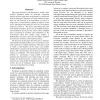Free Online Productivity Tools
i2Speak
i2Symbol
i2OCR
iTex2Img
iWeb2Print
iWeb2Shot
i2Type
iPdf2Split
iPdf2Merge
i2Bopomofo
i2Arabic
i2Style
i2Image
i2PDF
iLatex2Rtf
Sci2ools
107
Voted
ICRA
1998
IEEE
1998
IEEE
Position Estimation Using Principal Components of Range Data
1 sensors is to construct a structural description from sensor data and to match this description to a previously acquired model [Crowley 85]. An alternative is to project individual range measurements onto a previously acquired model [Leonard and Durrant-Whyte 91]. It is also possible to fuse range measurements directly using occupancy grids [Elfes 86], [Schiele 94]. Recently it has been shown that raw range data from nearby scans can be registered using a technique known as scan correlation [Weiss et al 95]. The correction vector from this technique provides a correction to position estimation. A thorough review in the state of the art in position estimation is provided in [Borenstein et al 96]. This paper describes a new approach to mobile robot position estimation based on principal component analysis of laser range data. An eigenspace is constructed from the principal components of a large number of range data sets. The structure of an environment, as seen by a range sensor, is re...
Related Content
| Added | 04 Aug 2010 |
| Updated | 04 Aug 2010 |
| Type | Conference |
| Year | 1998 |
| Where | ICRA |
| Authors | James L. Crowley, Frank Wallner, Bernt Schiele |
Comments (0)

